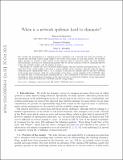| dc.contributor.author | Drakopoulos, Kimon | |
| dc.contributor.author | Koksal, Asuman E. | |
| dc.contributor.author | Tsitsiklis, John N | |
| dc.date.accessioned | 2017-08-28T18:03:43Z | |
| dc.date.available | 2017-08-28T18:03:43Z | |
| dc.date.issued | 2016-09 | |
| dc.date.submitted | 2015-09 | |
| dc.identifier.issn | 0364-765X | |
| dc.identifier.issn | 1526-5471 | |
| dc.identifier.uri | http://hdl.handle.net/1721.1/111028 | |
| dc.description.abstract | We consider the propagation of a contagion process (“epidemic”) on a network and study the problem of dynamically allocating a fixed curing budget to the nodes of the graph, at each time instant. For bounded degree graphs, we provide a lower bound on the expected time to extinction under any such dynamic allocation policy, in terms of a combinatorial quantity that we call the resistance of the set of initially infected nodes, the available budget, and the number of nodes n.
Specifically, we consider the case of bounded degree graphs, with the resistance growing linearly in n. We show that if the curing budget is less than a certain multiple of the resistance, then the expected time to extinction grows exponentially with n. As a corollary, if all nodes are initially infected and the CutWidth of the graph grows linearly, while the curing budget is less than a certain multiple of the CutWidth, then the expected time to extinction grows exponentially in n. The combination of the latter with our prior work establishes a fairly sharp phase transition on the expected time to extinction (sublinear versus exponential) based on the relation between the CutWidth and the curing budget. | en_US |
| dc.language.iso | en_US | |
| dc.publisher | Institute for Operations Research and the Management Sciences (INFORMS) | en_US |
| dc.relation.isversionof | http://dx.doi.org/10.1287/moor.2016.0792 | en_US |
| dc.rights | Article is made available in accordance with the publisher's policy and may be subject to US copyright law. Please refer to the publisher's site for terms of use. | en_US |
| dc.rights.uri | http://creativecommons.org/licenses/by-nc-sa/4.0/ | en_US |
| dc.source | arXiv | en_US |
| dc.title | When Is a Network Epidemic Hard to Eliminate? | en_US |
| dc.type | Article | en_US |
| dc.identifier.citation | Drakopoulos, Kimon et al. “When Is a Network Epidemic Hard to Eliminate?” Mathematics of Operations Research 42, 1 (January 2017): 1–14 © 2017 Institute for Operations Research and the Management Sciences (INFORMS) | en_US |
| dc.contributor.department | Massachusetts Institute of Technology. Department of Electrical Engineering and Computer Science | en_US |
| dc.contributor.department | Massachusetts Institute of Technology. Laboratory for Information and Decision Systems | en_US |
| dc.contributor.mitauthor | Drakopoulos, Kimon | |
| dc.contributor.mitauthor | Koksal, Asuman E. | |
| dc.contributor.mitauthor | Tsitsiklis, John N | |
| dc.relation.journal | Mathematics of Operations Research | en_US |
| dc.eprint.version | Original manuscript | en_US |
| dc.type.uri | http://purl.org/eprint/type/JournalArticle | en_US |
| eprint.status | http://purl.org/eprint/status/NonPeerReviewed | en_US |
| dspace.orderedauthors | Drakopoulos, Kimon; Ozdaglar, Asuman; Tsitsiklis, John N. | en_US |
| dspace.embargo.terms | N | en_US |
| dc.identifier.orcid | https://orcid.org/0000-0001-8288-5874 | |
| dc.identifier.orcid | https://orcid.org/0000-0002-1827-1285 | |
| dc.identifier.orcid | https://orcid.org/0000-0003-2658-8239 | |
| mit.license | OPEN_ACCESS_POLICY | en_US |
